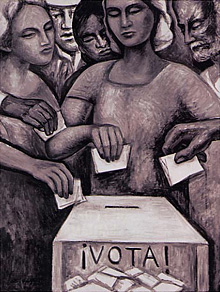Mexicans go to the polls on July 1, 2012, to select a new president, congress, mayor of Mexico City, and five governors. Elections in democratic societies have a way of confounding even the most seasoned political analysts, so there is no way of knowing how this one will turn out.
The most recent polls suggest that the Institutional Revolutionary Party (PRI) is far ahead in the presidential and congressional race. However, the incumbent National Action Party (PAN) won't select its presidential candidate until February and the general election campaign won't really start until then, according to Mexico's electoral rules, so anything can happen.
The PRI has some clear advantages. Enrique Peña Nieto is ahead by 20 points or more in most current polls. It remains the largest party in Mexico, with more than half the governorships, effective control of the lower house, and by far the largest public campaign financing as they are coalition with the Green Party (PVEM), and New Alliance Party (PANAL).
However, the PAN's likely candidate, Josefina Vázquez Mota, is a highly popular former cabinet secretary and congresswoman known for her charisma and public appeal, and the PAN has the advantage (and disadvantage) of being the party in power.
Meanwhile, Andrés Manuel López Obrador, the candidate of the left-of-center Democratic Revolutionary Party (PRD) and two smaller parties, The Workers' Party (PT), and The Citizens' Movement (PMC), is a talented and popular politician who nearly won the 2006 election and has spent the past five years building a support base in each one of Mexico's municipalities. This base that has yet to be tested, but could prove formidable if effective. It would be unwise to discount any of the three parties, although the early advantage is clearly with the PRI.
There are at least three possible scenarios. The first is that the current trends hold, and that the PRI marches to an overwhelming victory. Perhaps winning not only the presidency, but also a majority in the lower house of Congress (which requires reaching a threshold of 42% of the vote) as well as the mayor's race in Mexico City (where former PRI president Beatriz Paredes is set to compete).
A second, a probably more likely scenario, is that the election becomes much more competitive over time with either the PAN candidate or López Obrador - or both - competing effectively with Peña Nieto for the presidency and a much tighter race in the Congress. There, the outcome will depend a great deal on the candidates' ability to convince voters of their qualifications and the parties' mobilization strategies.
Finally, there is a highly unlikely scenario that Peña Nieto's candidacy could collapse, leaving it once again a race between the center-right and center-left as in 2006. The first two scenarios seem much more probable however, given current trends.
Continue reading this article on MexiData.com.


